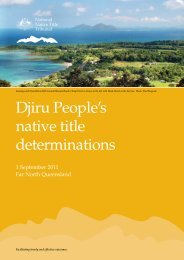Biodiveristy_State of Environment report - Mission Beach Cassowaries
Biodiveristy_State of Environment report - Mission Beach Cassowaries
Biodiveristy_State of Environment report - Mission Beach Cassowaries
- No tags were found...
Create successful ePaper yourself
Turn your PDF publications into a flip-book with our unique Google optimized e-Paper software.
These include areas where rainforest is encroaching ondrier forest, and where the ecosystem requires fire toregenerate and reproduce.QPWS have been focusing fire management in wetlandsystems including Eubenangee Swamp, and at the back <strong>of</strong>Maria Creek. These burns are timed to minimise risks, andto maximise the floristic response.Fire regimes have proved extremely successful at HullRiver outside the Shire, with unexpected further benefits.This resulted from the burning away <strong>of</strong> decades-deep leaflitter in the wetland. As a result the ground level droppedby almost a metre, completely restoring natural hydrologyto the area.The wetland at Kurrimine currently suffers from a similarproblem exacerbated by salinity incursion. This is becausethe compact leaf litter retains salt from king tides. Byburning this accumulated material a natural hydrologicalregime will be re-established to flush salt incursions backout <strong>of</strong> the system. Fire is an essential component inmaintaining both the floristic and hydrologicalcharacteristics <strong>of</strong> some wetland areas in the Shire.In recent years there has been large public concern aboutfire management, mainly from local residents when burningis taking place in their area. QPWS plan to promoteeducation on fire regimes and the necessity for fire forsustaining particular ecosystem types.CouncilIt is one <strong>of</strong> the recommendations <strong>of</strong> the Council’sBiodiversity Strategy (2003) that fire management plans aredeveloped for the Shire and appropriate technical advice issought on appropriate fire regimes for each <strong>of</strong> the regionalecosystems identified in the Strategy. Coordination withQPWS and Indigenous groups will be required, to establisha strategy that is appropriate in frequency and location.Council revegetation unit staff members require training incontrolled burning.Fire can also be valuable tool in the control <strong>of</strong> a number <strong>of</strong>weeds. One example is Pond apple, which is moresensitive to fire than melaleucas and has failed to establishin vegetation communities that are burned regularly (Bell,1996). This is an advantage for pest management work,where burning can control some introduced species.Rec: A strategic plan for fire management and regularscheduled controlled burns in the Shire be developed,involving all stakeholders - for vegetation dependent onfire in protected areas, on Council reserves, and onprivate land - Council, QPWS, Rural Fire-fighters,Indigenous organisationsRec: Council community revegetation unit staff be trained incontrolled burning for ecological maintenance and forweed control - CouncilRec: Wetland system hydrology be maintained whereappropriate with fire management regimes to bedeveloped - QPWS, CouncilRec: Fire management requires public engagementbeforehand, including promotion and advertisement <strong>of</strong>the issues through a public medium such as the paper -QPWS, Council2.1.5 Offshore Ecosystems - theBarnard IslandsThe only islands managed by QPWS Cairns Marine Parks inthe Johnstone Shire are the Barnard Islands. The islands willsoon fall under the jurisdiction <strong>of</strong> local QPWS marine<strong>of</strong>ficers to be based in Innisfail.PressurePressures on the islands include feral rats, which affect thebird populations, and exotic weed invasion. Visitation to theislands by people also requires some management. Theislands are a traditional part <strong>of</strong> the Ma:mu people’s ‘seacountry’so management and usage has to be culturallysensitive.ConditionThe islands are recognised as important seabird breedingareas. Recorded numbers have estimated population levels attimes in the region <strong>of</strong> 10,000 bridled terns, 2,000 lessercrestedterns, and 2,000 black-naped terns. A total <strong>of</strong> 26species <strong>of</strong> seabirds has been recorded on and around theislands, including species identified under the NatureConservation Act such as the <strong>Beach</strong> Stone Curlew -vulnerable, and Sooty Oystercatcher - rare. The islands havea diversity <strong>of</strong> floral communities with the likelihood <strong>of</strong>species <strong>of</strong> conservation significance amongst them.Surrounding the islands are reefs. The condition <strong>of</strong> thesereefs is discussed in the Aquatic ecosystems section 3.1.ResponseThere is an approved management plan by QPWS for all the43



